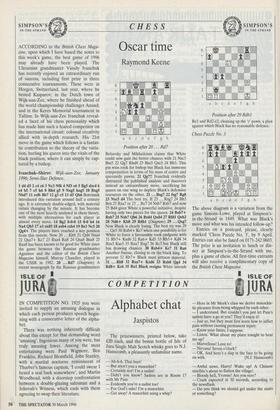SIMPSON'S
IN-THE•STRAND
SIMPSON'S
IN-THE-STRAND
Oscar time
Raymond Keene
ACCORDING to the British Chess Maga- zine, upon which I have based the notes to this week's game, the best game of 1996 may already have been played. The Ukrainian grandmaster Vassily Ivanchuk has recently enjoyed an extraordinary run of success, including first prize in three consecutive tournaments. These were at Horgen, Switzerland, last year, where he bested Kasparov; in the Dutch town of Wijk-aan-Zee, where he finished ahead of the world championship challenger Anand; and in the Keres Memorial tournament in Tallinn. In Wijk-aan-Zee Ivanchuk reveal- ed a facet of his chess personality which has made him such a feared competitor on the international circuit: colossal creativity allied with in-depth research. His 21st move in the game which follows is a fantas- tic contribution to the theory of the varia- tion, hurling his queen into the vitals of the black position, where it can simply be cap- tured by a bishop.
Ivanchuk–Shirov: Wijk-aan-Zee, January 1996; Semi-Slav Defence.
1 d4 d5 2 c4 c6 3 Nc3 Nf6 4 Nf3 e6 5 Bg5 dxc4 6 e4 b5 7 e5 h6 8 Bh4 g5 9 Nxg5 hxg5 10 Bxg5 Nbd7 11 exf6 Bb7 12 g3 c5 13 d5 Qb6 Botvinnik introduced this variation around half a century ago. It is extremely double-edged, with material values changing by the minute. It has become one of the most heavily analysed in chess theory, with multiple alternatives for each player at almost every move. 14 Bg2 0-0-0 15 0-0 b4 16 Na4 Qb5 17 a3 exd5 18 axb4 cxb4 19 Be3 Nc5 20 Qg4+ The players have reached a key position from this system. Now 20 ...Kb8 21 Qd4 Nxa4 22 Qxa7+ Kc7 23 Rxa4 Ra8 24 Qxa8 Bxa8 25 Ftxa8 has been known to be good for White since the game between the Russian grandmaster Agzamov and the editor of the British Chess Magazine himself, Murray Chandler, played in the USSR in 1982. 20 ...Rd7 (Diagram) A recent monograph by the Russian grandmasters
Position after 20. . . Rd7
Beliavsky and Mikhailcisin claims that White could now gain the better chances with 21 Nxc5 Bxc5 22 Qg7 Rhd8 23 Bxc5 Qxc5 24 Bh3. This pin wins rook for bishop but Black has immense compensation in terms of his mass of centre and queenside pawns. 21 Qg7!! Ivanchuk evidently distrusted the published analysis and discovers instead an extraordinary move, sacrificing his queen on one wing to deplete Black's defensive resources on the other. 21 ... Bxg7 22 fxg7 Rg8 23 Nxc5 d4 The best try. If 23 ... Rxg7 24 Bh3 Bc6 25 Rxa7 or 23 ... Rc7 24 Nxb7 Rxb7 and now 25 Bd4 gives White a powerful initiative, despite having only two pieces for the queen. 24 Bxb7+ Rxb7 25 Nxb7 Qb6 26 Bxd4 Qxd4 27 Rfdl Qxb2 28 Nd6+ Kb8 29 Rdbl (Diagram) 29 ... Qxg7 Now Black is clearly losing. The best try was 29
Qe5 30 Rxb4 + Kc7 when one possibility is for White to force a favourable rook endgame with 31 Rb7+ Kxd6 32 Ra6+ Kd5 33 Rb5+ Kd4 34 Rxe5 Kxe5 35 Rxa7 Rxg7 36 Rc7 but Black still has drawing chances. 30 Rxb4+ Kc7 31 Ra6 Another finesse, closing in on the black king. To prevent 32 Rb7+ Black must jettison material. 31 ...Rb8 32 Rxa7+ Kxd6 33 Rxb8 Qg4 34 Rd8+ Kc6 35 Ral Black resigns White intends
Position after 29 Rdbl
Rd l and Rd2-c2, cleaning up the 'c' pawn, a plan against which Black has no reasonable defence.
Chess Puzzle No. 3 The above diagram is a variation from the game Simons—Lowe, played at Simpson's- in-the-Strand in 1849. What was Black's move and what was his intended follow-up?
Entries on a postcard, please, clearly marked 'Chess Puzzle No. 3', by 9 April. Entries can also be faxed on 0171-242 0603. The prize is an invitation to lunch or din- ncr at Simpson's-in-the-Strand with me, plus a game of chess. All first-time entrants will also receive a complimentary copy of the British Chess Magazine.


























































 Previous page
Previous page